Edimax Technology Co 9572881411 AC450 WLAN Band Extender User Manual
Edimax Technology Co Ltd AC450 WLAN Band Extender
user manual
1
AC450 Wireless LAN
11ac Band Extender
(IEEE 802.11a/an/ac)
User’s Manual
Version: 1.0
(JUNE, 2014)
2
COPYRIGHT
Copyright ©2014 by this company. All rights reserved. No part of this publication
may be reproduced, transmitted, transcribed, stored in a retrieval system, or translated
into any language or computer language, in any form or by any means, electronic,
mechanical, magnetic, optical, chemical, manual or otherwise, without the prior
written permission of this company
This company makes no representations or warranties, either expressed or implied,
with respect to the contents hereof and specifically disclaims any warranties,
merchantability or fitness for any particular purpose. Any software described in this
manual is sold or licensed "as is". Should the programs prove defective following
their purchase, the buyer (and not this company, its distributor, or its dealer) assumes
the entire cost of all necessary servicing, repair, and any incidental or consequential
damages resulting from any defect in the software. Further, this company reserves the
right to revise this publication and to make changes from time to time in the contents
thereof without obligation to notify any person of such revision or changes.
3
Federal Communication Commission
Interference Statement
FCC Part 15
This device complies with part 15 of the FCC Rules. Operation is subject to the
following two conditions: (1) This device may not cause harmful interference, and (2)
this device must accept any interference received, including interference that may
cause undesired operation.
This equipment has been tested and found to comply with the limits for a Class B
digital device, pursuant to Part 15 of FCC Rules. These limits are designed to provide
reasonable protection against harmful interference in a residential installation. This
equipment generates, uses, and can radiate radio frequency energy and, if not installed
and used in accordance with the instructions, may cause harmful interference to radio
communications. However, there is no guarantee that interference will not occur in a
particular installation. If this equipment does cause harmful interference to radio or
television reception, which can be determined by turning the equipment off and on,
the user is encouraged to try to correct the interference by one or more of the
following measures:
1. Reorient or relocate the receiving antenna.
2. Increase the separation between the equipment and receiver.
3. Connect the equipment into an outlet on a circuit different from that to
which the receiver is connected.
4. Consult the dealer or an experienced radio technician for help.
Changes or modifications not expressly approved by the party responsible for
compliance could void the user‘s authority to operate the equipment.
Operations in the 5.15-5.25 & 5.75-5.85 GHz band are restricted to indoor usage
only.
4
FCC Caution
This equipment must be installed and operated in accordance with provided
instructions and a minimum 20 cm spacing must be provided between computer
mounted antenna and person’s body (excluding extremities of hands, wrist and feet)
during wireless modes of operation.
This device complies with Part 15 of the FCC Rules. Operation is subject to the
following two conditions: (1) this device may not cause harmful interference, and (2)
this device must accept any interference received, including interference that may
cause undesired operation.
Any changes or modifications not expressly approved by the party responsible for
compliance could void the authority to operate equipment.
This device is restricted to indoor use when operated in the 5.15-5.25 & 5.75-5.85
GHz frequency range.
Federal Communication Commission (FCC) Radiation Exposure
Statement
This equipment complies with FCC radiation exposure set forth for an uncontrolled
environment. In order to avoid the possibility of exceeding the FCC radio frequency
exposure limits, human proximity to the antenna shall not be less than 20cm (8 inches)
during normal operation.
The antenna(s) used for this transmitter must not be co-located or operating in
conjunction with any other antenna or transmitter.
5
R&TTE Compliance Statement
This equipment complies with all the requirements of DIRECTIVE 1999/5/EC OF
THE EUROPEAN PARLIAMENT AND THE COUNCIL of March 9, 1999 on radio
equipment and telecommunication terminal Equipment and the mutual recognition of
their conformity (R&TTE).
The R&TTE Directive repeals and replaces in the directive 98/13/EEC
(Telecommunications Terminal Equipment and Satellite Earth Station Equipment) As
of April 8, 2000.
Safety
This equipment is designed with the utmost care for the safety of those who install
and use it. However, special attention must be paid to the dangers of electric shock
and static electricity when working with electrical equipment. All guidelines of this
and of the computer manufacture must therefore be allowed at all times to ensure the
safe use of the equipment.
EU Countries Intended for Use
The ETSI version of this device is intended for home and office use in Austria,
Belgium, Denmark, Finland, France, Germany, Greece, Ireland, Italy, Luxembourg,
the Netherlands, Portugal, Spain, Sweden, and the United Kingdom.
The ETSI version of this device is also authorized for use in EFTA member states:
Iceland, Liechtenstein, Norway, and Switzerland.
EU Countries Not intended for use
None.
6
CATALOG
Chapter I: Product Information ..................................................................................... 7
1-1 Introduction and safety information ................................................................ 7
1-2 Safety Information ........................................................................................... 8
1-3 System Requirements .................................................................................... 10
1-4 Package Contents ........................................................................................... 11
1-5 Familiar with your new 11ac Band Extender ................................................ 12
Chapter II: System and Network Setup ........................................................................ 13
2-1 Build network connection .............................................................................. 13
2-2 Network setup ................................................................................................ 14
Chapter III WEB GUI configuration ........................................................................... 23
3-1 Setup Wizard .................................................................................................. 23
3-1-1 Access Point mode ............................................................................. 23
3-1-2 Client mode ........................................................................................ 27
3-2 Advanced Setup ............................................................................................. 31
3-3 WPS Setup ..................................................................................................... 33
3-4 Status ............................................................................................................. 34
Chapter IV: Appendix ................................................................................................... 36
4-1 Hardware Specification ................................................................................. 36
4-2 Troubleshooting ............................................................................................. 37
4-3 Glossary ......................................................................................................... 39
7
ChapterI:ProductInformation
1‐1Introductionandsafetyinformation
Thank you for purchasing this AC450 Wireless LAN 11ac Band Extender!
This cost-effective product is the best choice for Digital Home / Home
Office users, all network devices can share a single xDSL / cable modem
internet connection at 5G 11ac high speed.
With built-in 5GHz radio, this band extender supports IEEE
802.11a/an/ac wireless network capabilities, all wireless-enabled network
devices (including PDA, Smart phone, Game console, Tablet, TV, Set Top
Box and more!) can connect to this wireless band extender without
additional cabling, you can transfer audio / video / file for up to 433Mbps
(transfer data rate)!
Other features of this band extender including:
Supports 5GHz wireless LAN only.
High wireless access throughput, up to 433Mbps (transfer data rate)!
Allow multiple users to share a single Internet line.
Share a single Cable or xDSL internet connection.
Access private LAN servers from the internet.
One RJ-45 LAN Fast Ethernet port (10/100M).
Provides IEEE 802.11a/an/ac wireless LAN capability.
Support DHCP (Server/Client) for easy IP-address setup.
Support multiple wireless modes like: Access Point, Client.
Easy to use Web-based GUI for network configuration and
management purposes.
Auto MDI / MDI-X function for wired Ethernet port.
8
1‐2SafetyInformation
In order to keep the safety of users and your properties, please follow the
following safety instructions:
1. This band extender is designed for indoor use only; DO NOT place this
band extender outdoor.
2. DO NOT put this band extender at or near hot or humid places, like
kitchen or bathroom. Also, do not left this band extender in the car in
summer.
3. DO NOT plug, unplug & rotation LAN port with force.
4. If you want to place this band extender at high places or hang on the
wall, please make sure the band extender is firmly secured. Falling from
high places would damage the band extender and its accessories, and
warranty will be void.
5. Accessories of this band extender, like antenna, cable and power supply,
are danger to small children under 3 years old. They may put the small
parts in their nose or month and it could cause serious damage to them.
KEEP THIS BAND EXTENDER OUT THE REACH OF CHILDREN!
6. The band extender will become hot when being used for long time
(This is normal and is not a malfunction). DO NOT put this band
extender on paper, cloth, or other flammable materials.
7. There’s no user-serviceable part inside the band extender. If you found
that the product is not working properly, please contact your dealer of
purchase and ask for help. DO NOT disassemble the producy, warranty
will be void.
8. If the product falls into water when it’s powered, DO NOT use your
hand to pick it up. Switch the electrical power off before you do anything,
or contact an experienced technician for help.
9
9. If you smell something strange, or even see some smoke coming out
from the product or power supply, remove the power supply or switch the
electrical power off immediately, and call dealer of purchase for help.
10
1‐3SystemRequirements
Internet connection, provided by xDSL or cable modem with a RJ-45
Ethernet port.
Network devices with wired or 5G wireless network interface card.
Web browser (Microsoft Internet Explorer, Google Chrome, Firefox or
Safari web browser).
An available USB Port or USB power adapter (Output: DC5V/0.6A)
11
1‐4PackageContents
Before starting to use this 11ac band extender, please check if there’s
anything missing in the package, and contact your dealer of purchase to
claim for missing items:
□ 11ac Band Extender (1 pcs)
□ Quick Installation Guide (1 pcs)
□ User Manual CD-ROM (1 pcs)
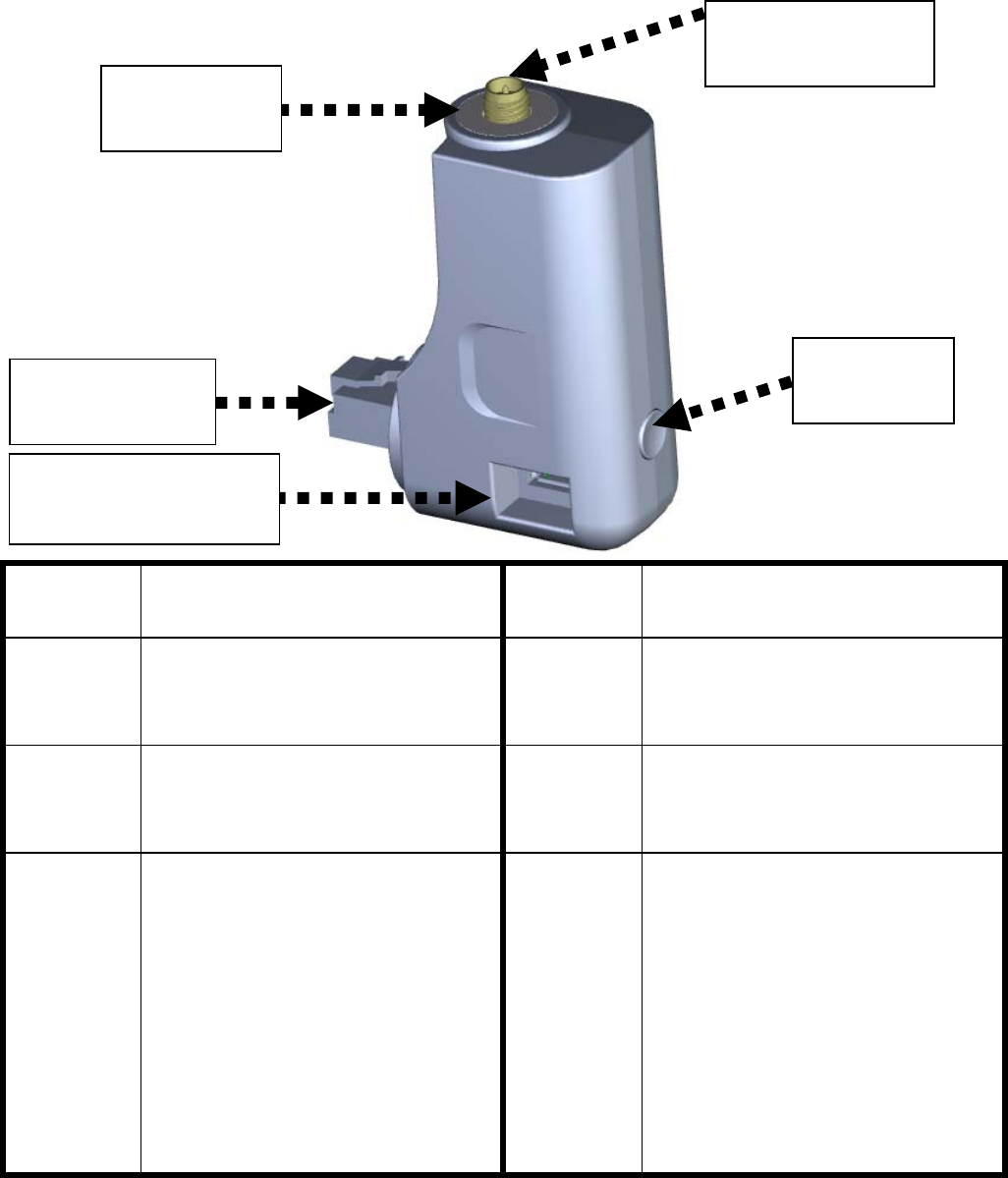
12
1‐5Familiarwithyournew11acBandExtender
LEDindication&ButtonFunction
LED
Indication
Definition Function Definition
AP
mode
(Orange)
Blinking: Wireless LAN activity
(transferring or receiving data)
RJ-45
Ethernet
AP mode: LAN Port
Client mode: LAN Port
Client
mode
(Blue)
Blinking: Wireless LAN activity
(transferring or receiving data)
Micro USB
Connector
For 11ac band extender power
supply only.
System
status
(Purple)
On Solid: Detect WPS button is
pressed and hold for more 3
seconds, Wireless WPS function
is enabled.
Blinking: Detect Reset button is
pressed and hold for more 10
seconds. (do restore all settings
to factory defaults).
WPS /
Reset
WPS: Pressed and hold for
more 3 seconds to start WPS.
Reset: Pressed and hold for
more 10 seconds, till LED is
blinking to do restore all settings
to factory defaults.
LED indicate
SMA for Antenna
RJ-45 Ethernet
Micro USB for power
Reset/WPS
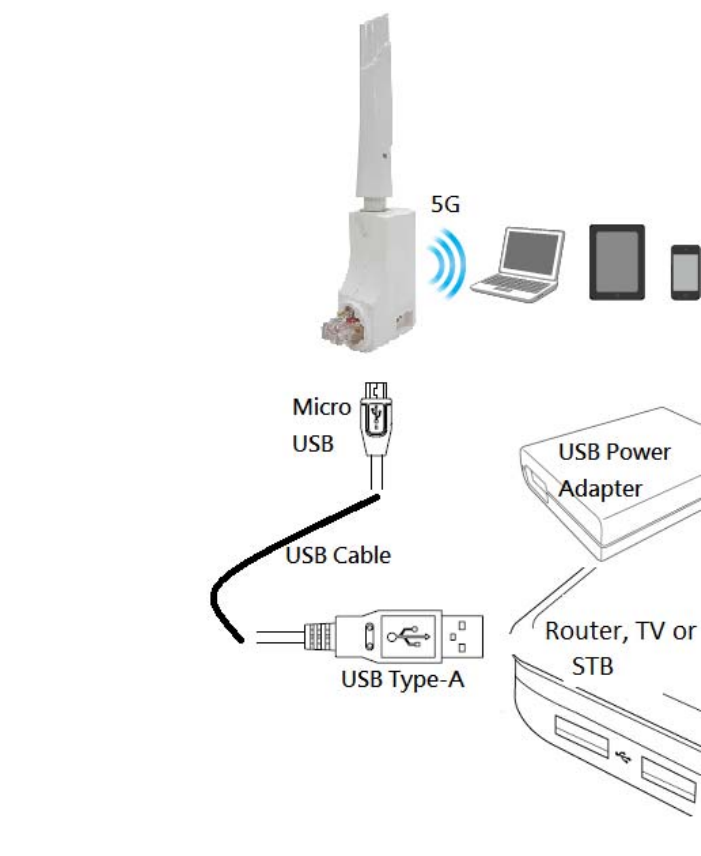
13
ChapterII:SystemandNetworkSetup
2‐1Buildnetworkconnection
Please follow the following instructions to setup 11ac band extender:
1. Please connect the USB cable (Micro USB) to the 11ac band extender.
2. Please connect the USB cable (Type-A) to the Router, TV or Set Top
Box USB Port to getting the power supply, You can also use USB
power adapter to the wall outlet, and then connect USB cable (Type-A)
to the “USB Power Jack” to getting the power supply.
3. First time to setting the band extender, please do not plug band
extender to the Router's LAN port.
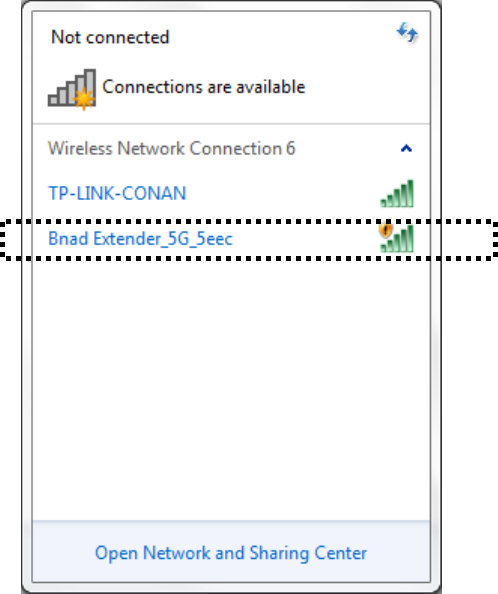
14
2‐2Networksetup
Please use the web browser to configure the 11ac band extender. A
computer with Ethernet or 5G wireless LAN connection to the band
extender is required for this first time configuration.
1. Site survey by 5G wireless LAN adapter and use Windows Zero
Configure, you can find 11ac Band Extender call the “Band
Extender_5G_xxxx”, please select and connect.
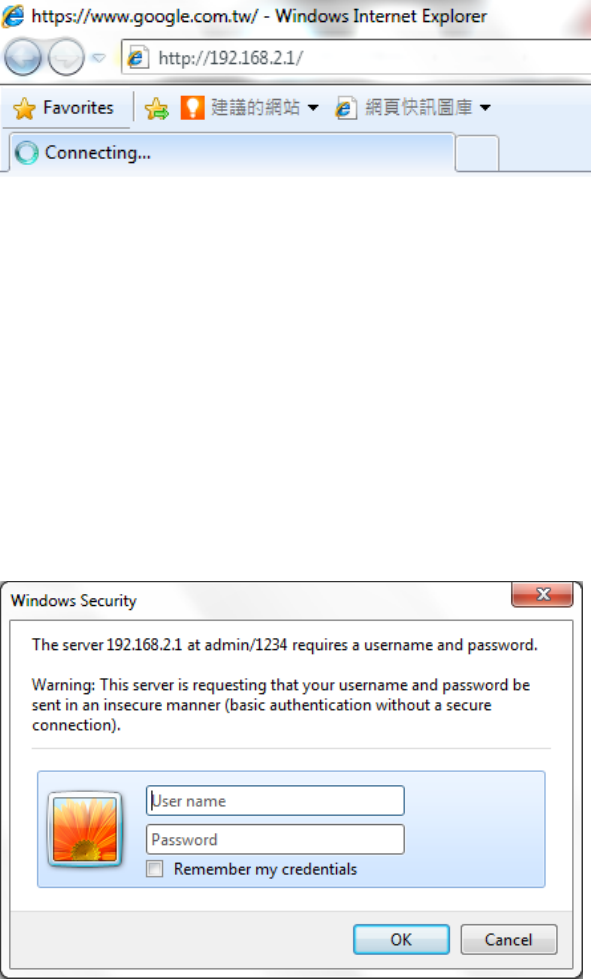
15
2. Open the web browser and input the IP address of 11ac Band Extender
in address bar, and the following message should be shown.
Default IP: 192.168.2.1
3. Please input user name and password, then click ‘OK’ to access web
management interface of 11ac Band Extender.
Default User name: admin
Default Password: 1234
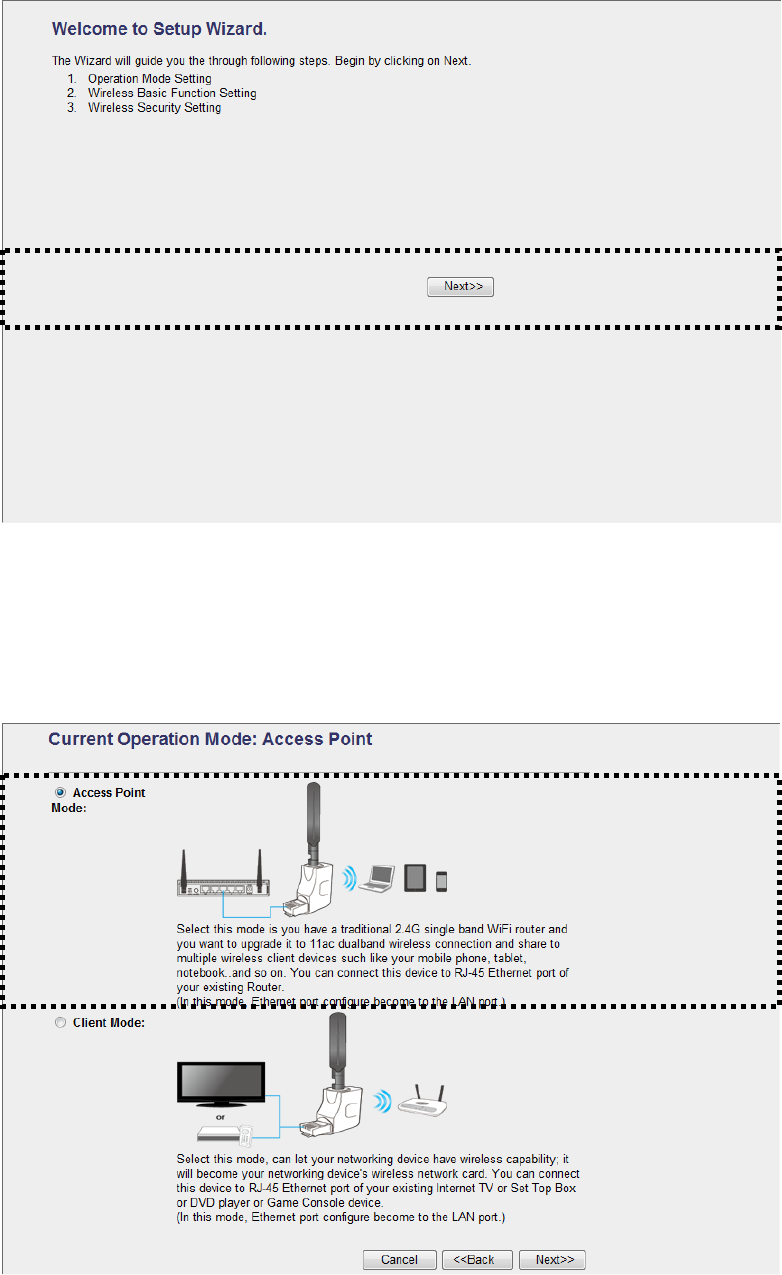
16
4. First time configure the 11ac Band Extender will auto into setup wizard,
please click “Next”.
5. Select operation mode: you can select AP mode or Client mode by your
application environment, then click “Next”.
(for example: AP mode)
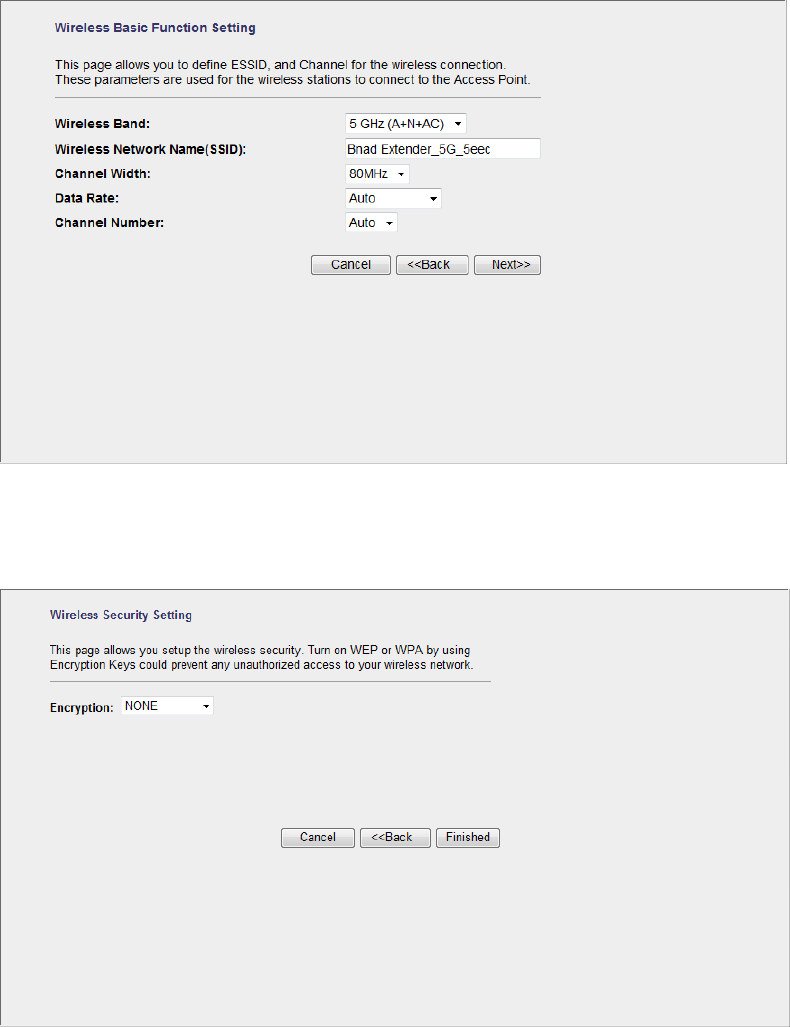
17
6. Wireless Basic Function Setting, click “Next”’ when you finish.
7. Wireless Security Setting, click “Finished”’ when you finish.
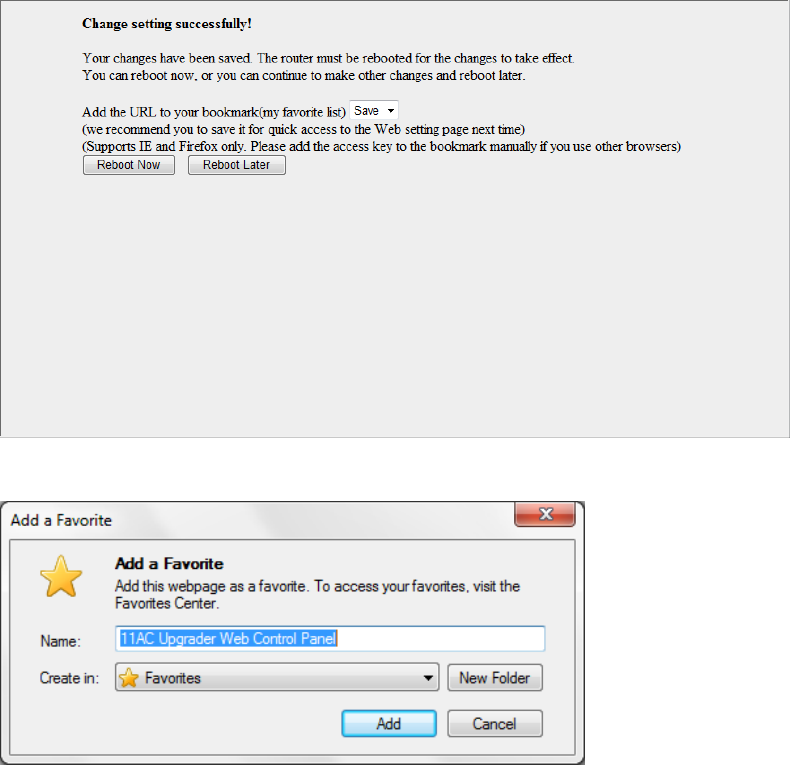
18
8. Change Setting Successfully, please press “Reboot Now” to restart the
11ac Band Extender to make the changes take effect.
Add the URL to your bookmark (my favorite list) Default: "Save"
(we recommend you to save it for quick access to the Web setting page
next time)
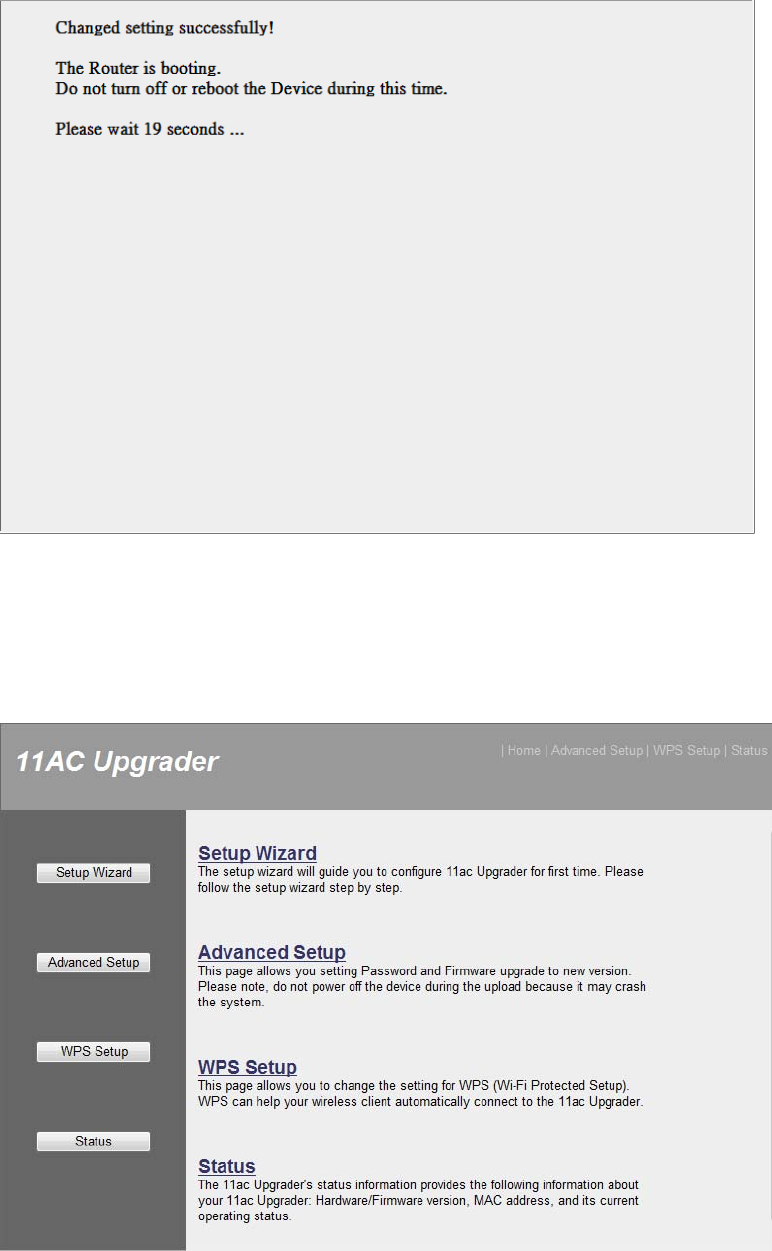
19
9. When you see this message, the 11ac Band Extender will be ready with
new settings within 20 seconds.
10. When you will re-configure the 11ac Band Extender, you can find
your favorite list. Select “11AC Upgrader Web Control Panel” into
Web management page.
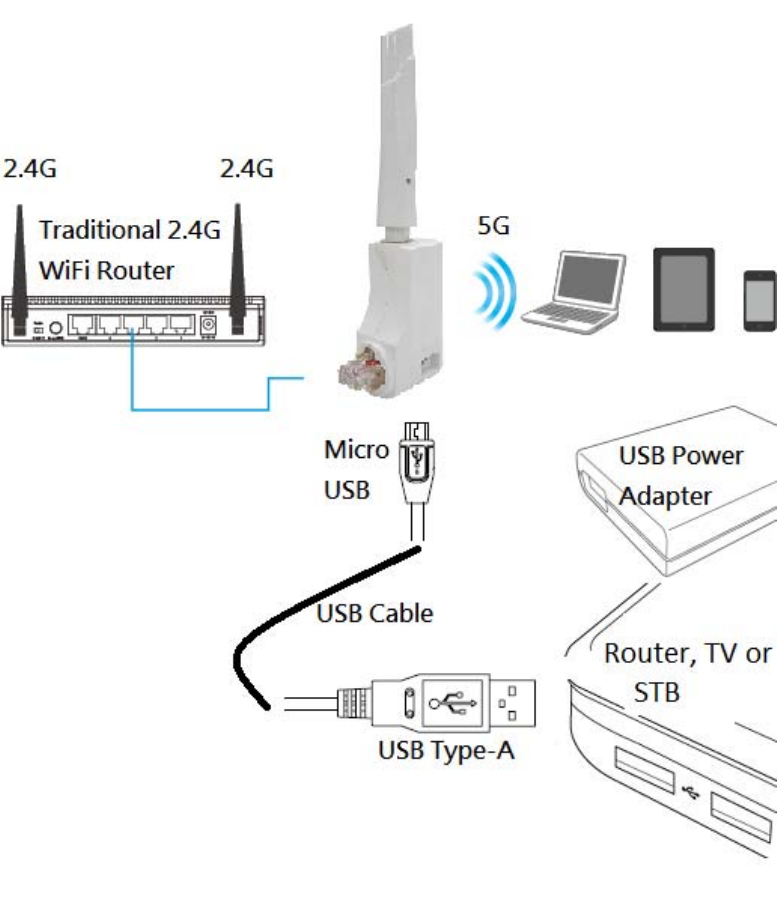
20
11. Please insert the 11ac band extender into an available LAN port of
your traditional 2.4G WiFi router.
(** Do not use force to plug or unplug the 11ac band extender.)
Please use your computer to connect to any website on Internet, or
start any Internet application and see if they’re working properly.
For instructions of advanced settings and wireless network setup,
please refer to user manual in supplied CD-ROM.
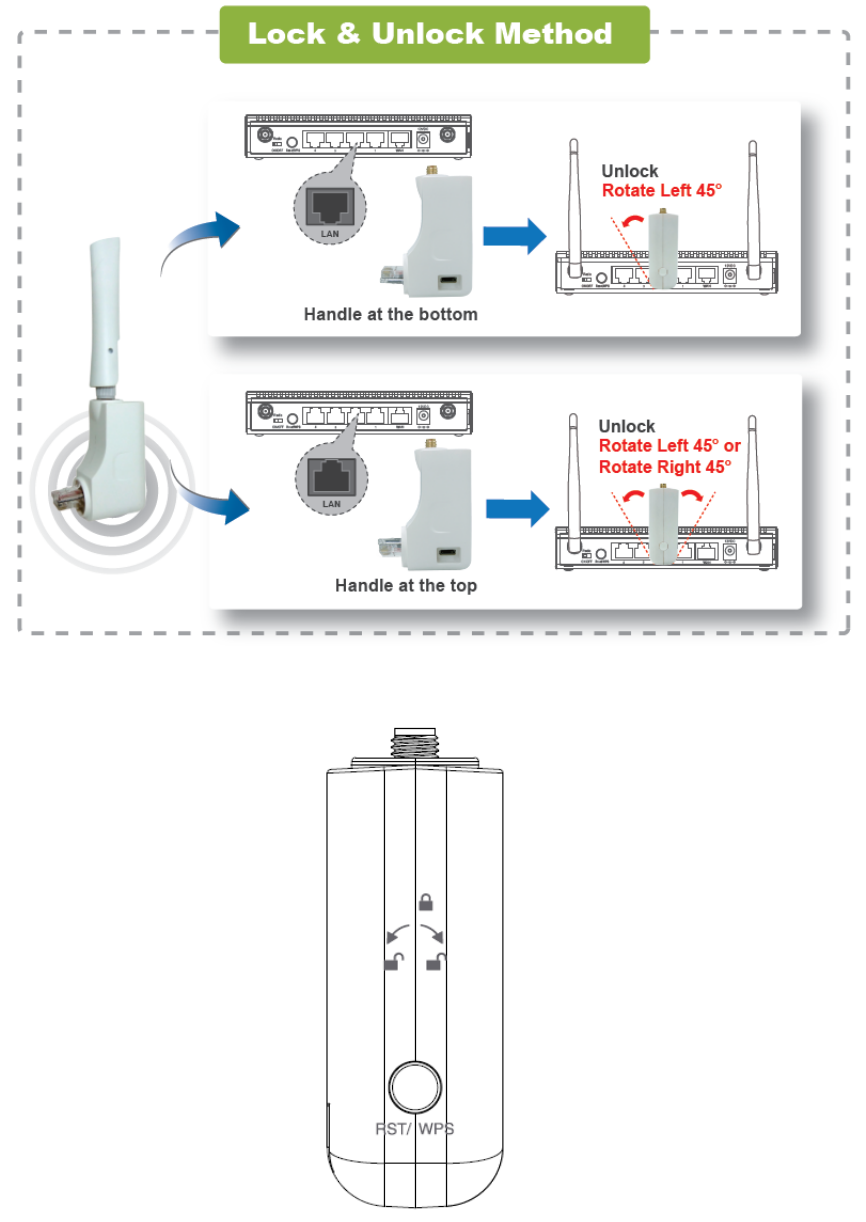
21
12. Lock & Unlock method for 11ac band extender as left drawing shown,
Please do not use force to plug, unplug or rotation the 11ac band
extender.

22
NOTE: If you can’t see the web management interface, and you’re
being prompted to input user name and password again, it means you
didn’t input username and password correctly. Please retype user
name and password again. If you’re certain about the user name and
password you type are correct, please go to ‘4-2 Troubleshooting’ to
perform a factory reset, to set the password back to default value.
TIP: This page shows the four major setting categories: Setup Wizard,
Advanced Setup, WPS Setup and Status. You can find the shortcut
which leads to these setting categories at the upper-right corner of
every page, and you can jump to another category directly by clicking
the link, and don’t have to go back to the first page.
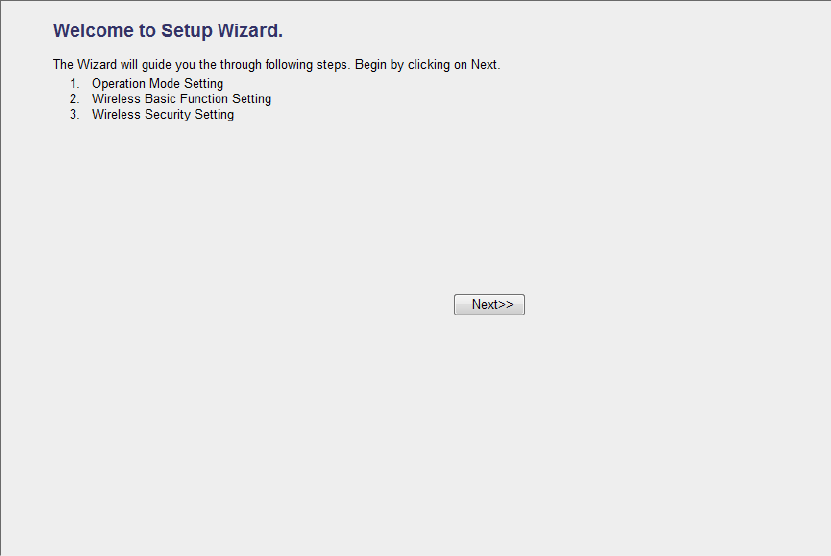
23
ChapterIIIWEBGUIconfiguration
3‐1SetupWizard
The setup wizard will guide you to configure 11ac Band Extender for first
time. Please follow the setup wizard step by step.
Welcome to Setup Wizard, please click “Next”.
3‐1‐1AccessPointmode
Select this mode is you have a traditional 2.4G single band WiFi router
and you want to upgrade it to 11ac dualband wireless connection and
share to multiple wireless client devices such like your mobile phone,
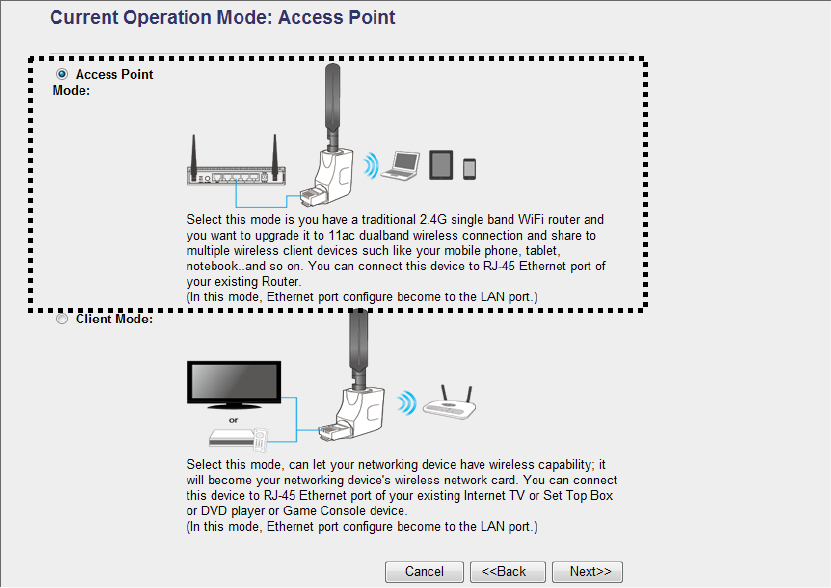
24
tablet, notebook..and so on. You can connect this device to RJ-45
Ethernet port of your existing Router.
(In this mode, Ethernet port configure become to the LAN port.)
Select operation mode: Please select “Access Point” mode, then click
“Next”.
Wireless Basic Function Setting: You can setting wireless band,
wireless network name (SSID), channel width, data rate and channel
number, then click “Next”’ when you finish.
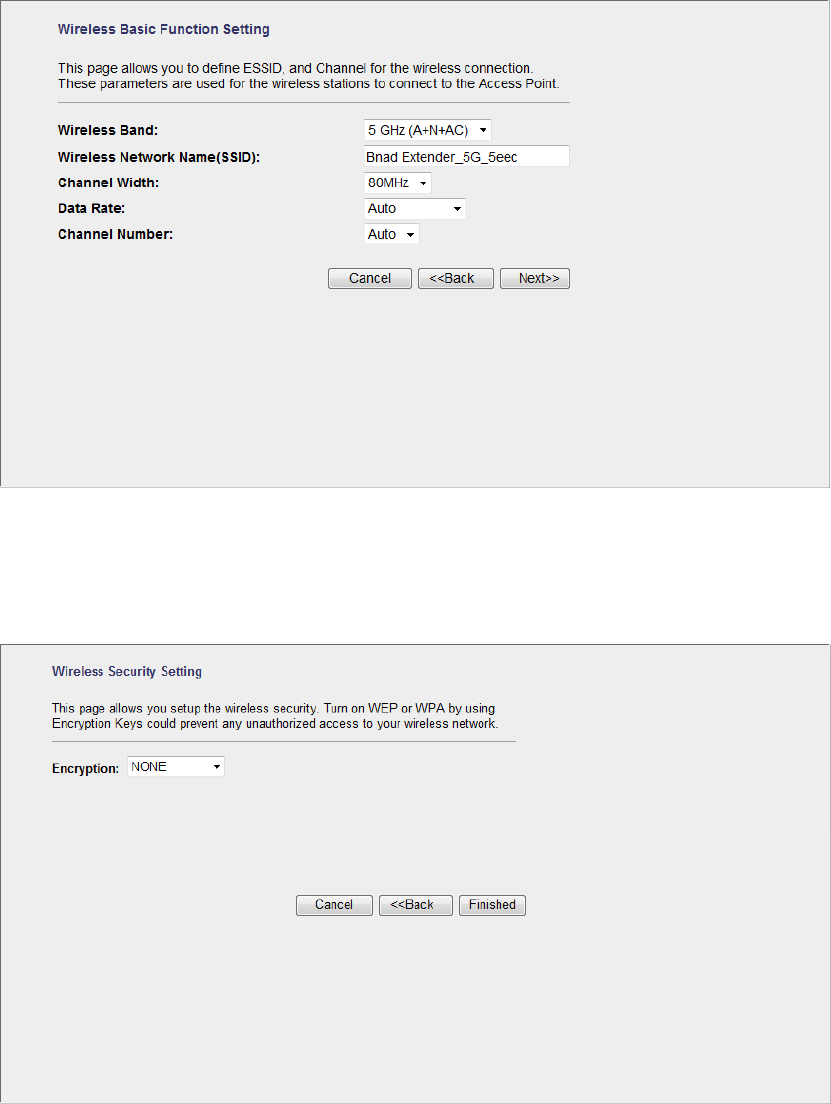
25
Wireless Security Setting: You can setting encryption for your wireless
security, then click “Finished”’ when you finish.
Change Setting Successfully: Please press “Reboot Now” to restart the
Band Extender to make the changes take effect.
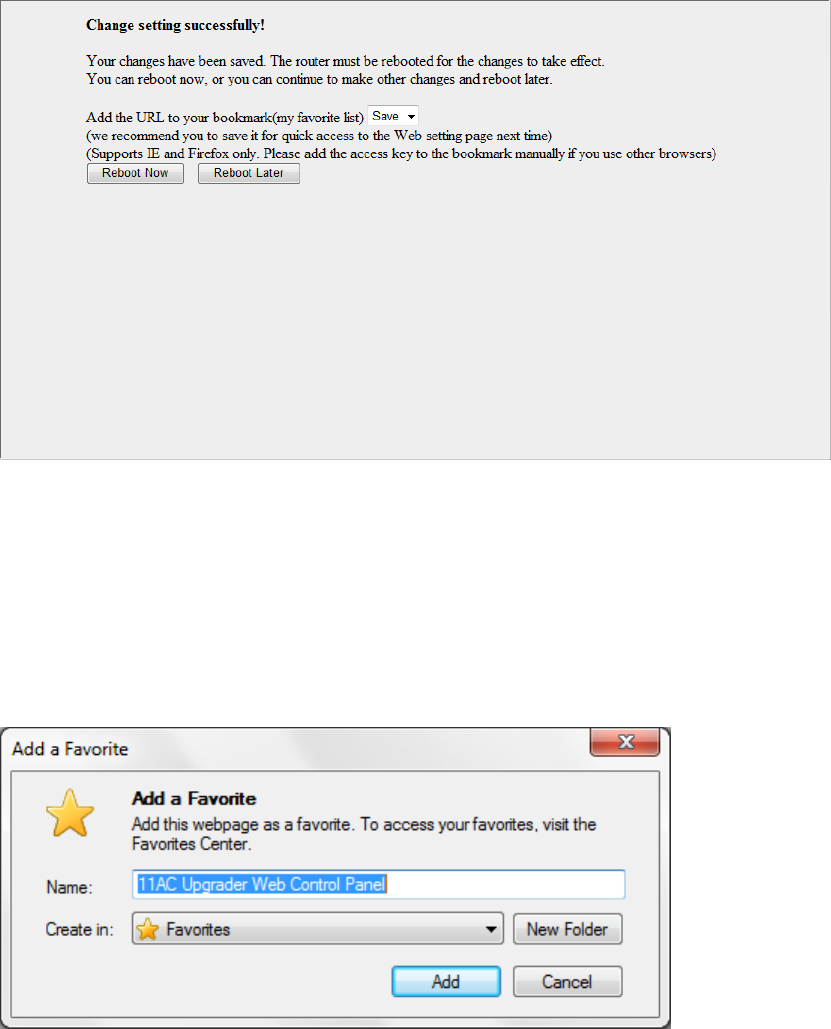
26
Add the URL to your bookmark (my favorite list) Default: "Save"
(we recommend you to save it for quick access to the Web setting page
next time)
(Supports IE and Firefox only. Please add the access key to the bookmark
manually if you use other browsers)
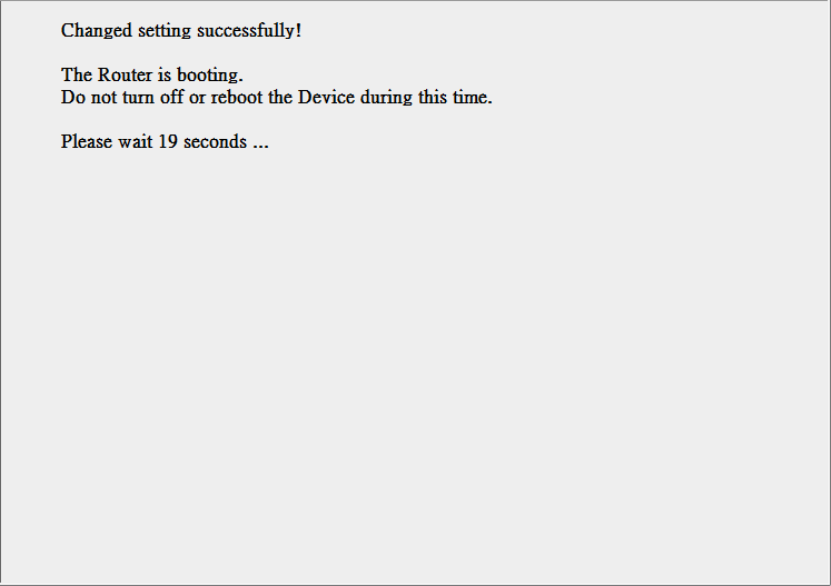
27
3‐1‐2Clientmode
Select this mode, can let your networking device have wireless capability;
it will become your networking device's wireless network card. You can
connect this device to RJ-45 Ethernet port of your existing Internet TV or
Set Top Box or DVD player or Game Console device.
(In this mode, Ethernet port configure become to the LAN port.)
Select operation mode: Please select “Client” mode, then click “Next”.
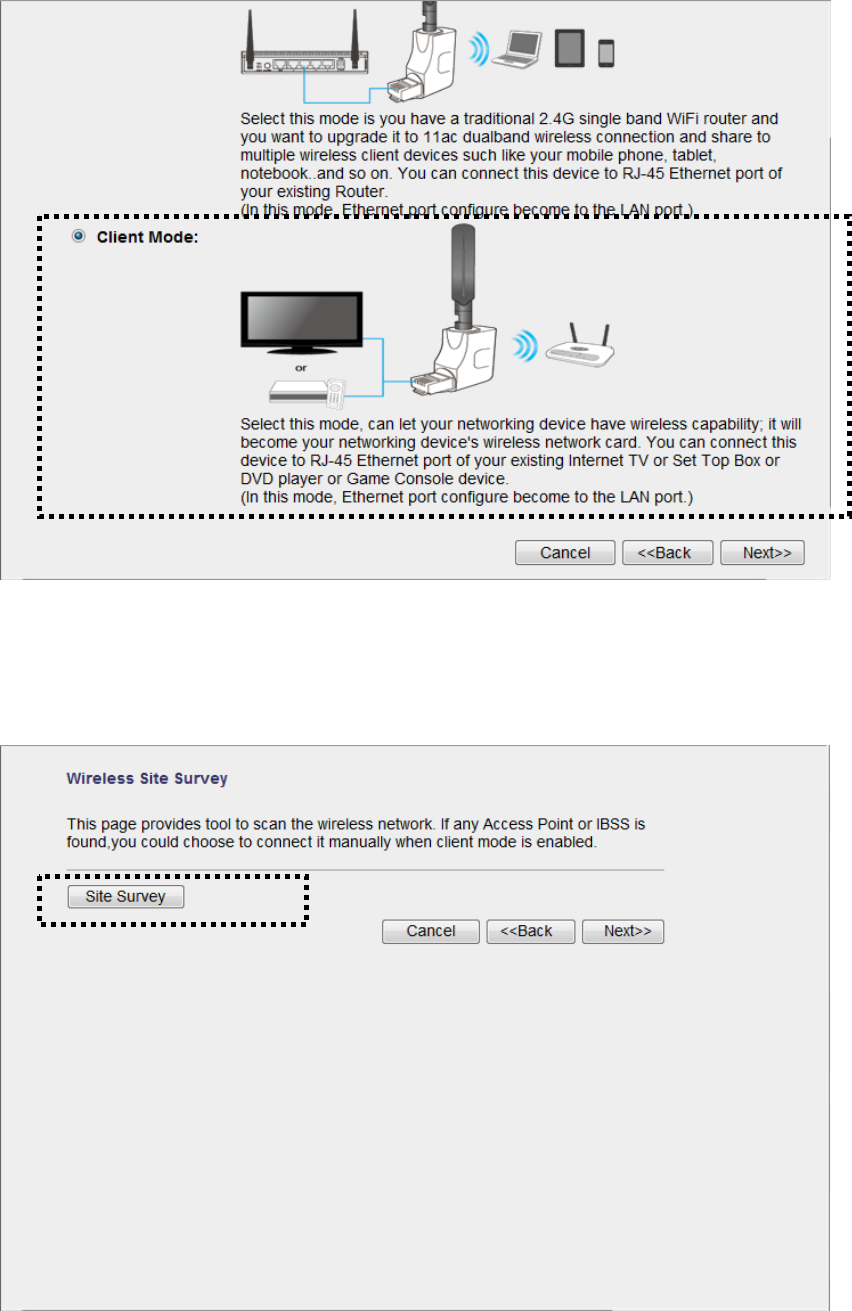
28
Wireless Site Survey: Please click “Site Survey” button to find WiFi AP
in your area.
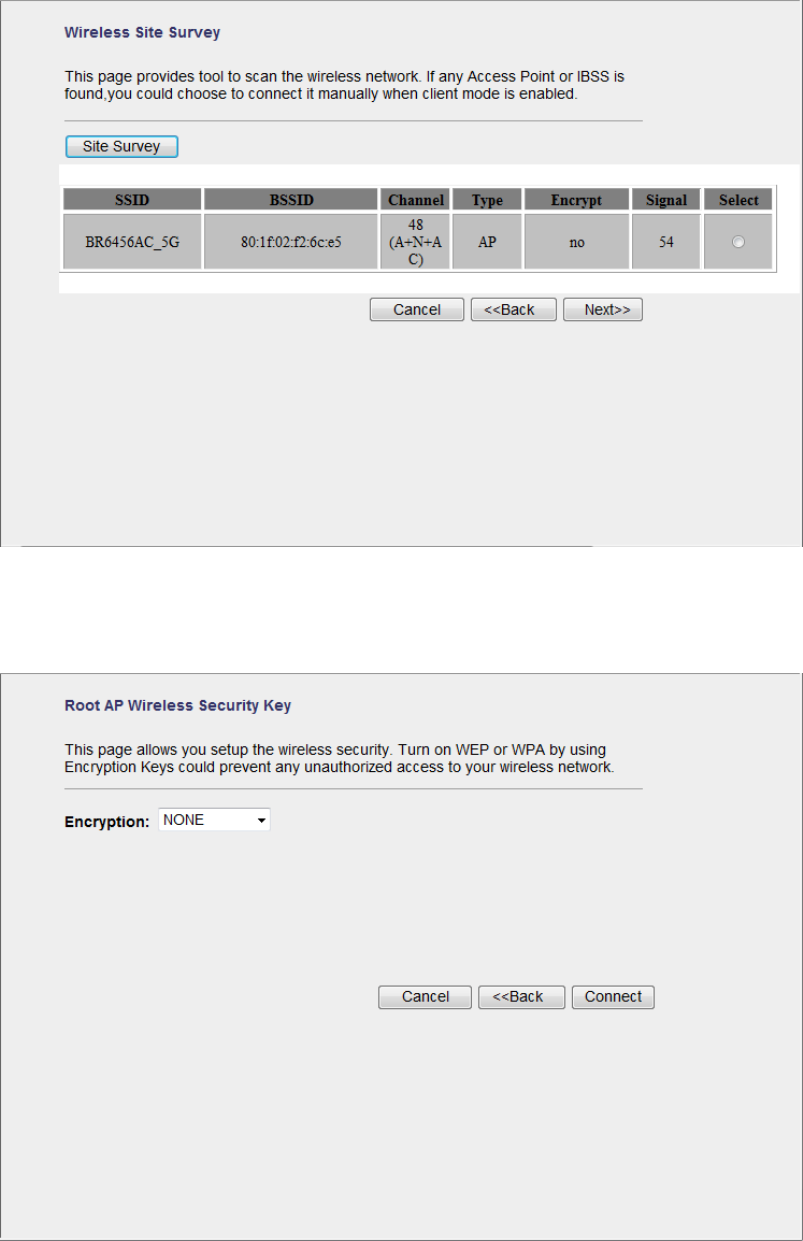
29
This page provides tool to scan the wireless network. If any Access Point
or IBSS is found, you could choose to connect it manually. Please select a
Root wireless AP and click “Next”.
Root AP Wireless Security Key: Please setting encryption for the Root
AP just you selected, then click “Connect”’ when you finish.
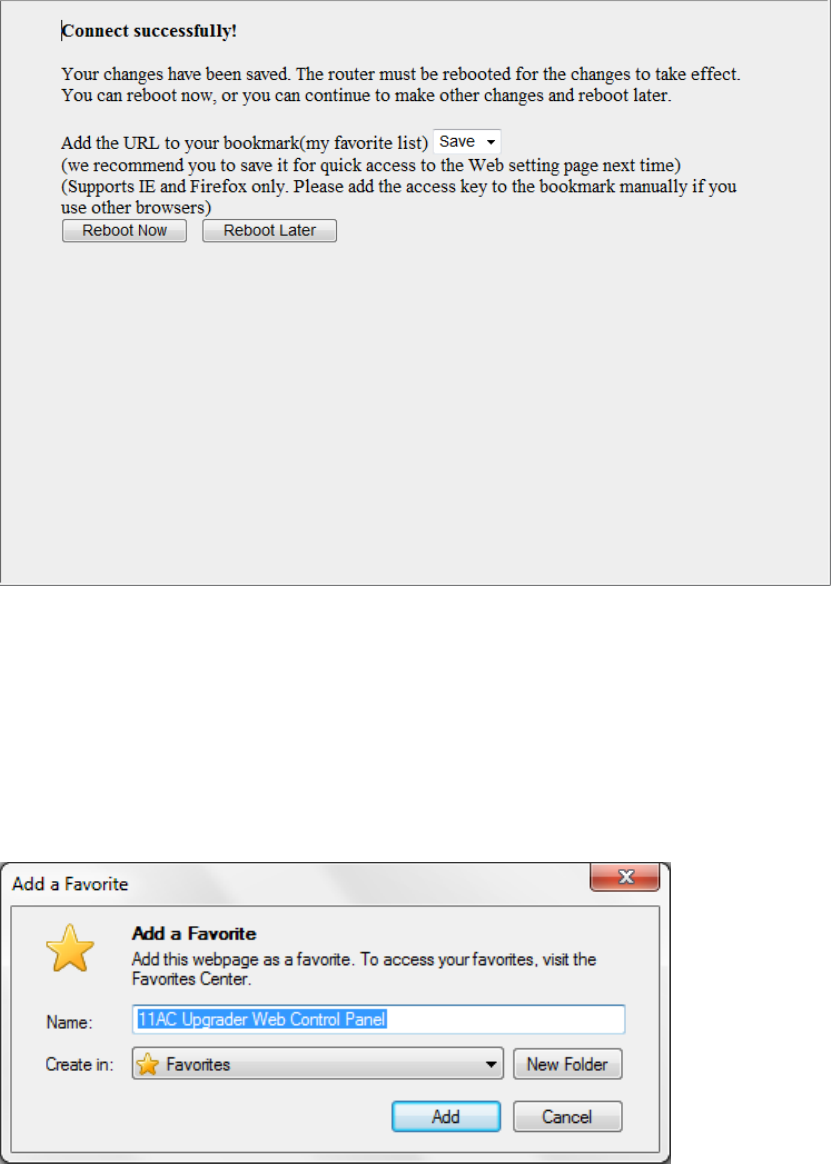
30
Connect Successfully: Please press “Reboot Now” to restart the Band
Extender to make the changes take effect.
Add the URL to your bookmark (my favorite list) Default: "Save"
(we recommend you to save it for quick access to the Web setting page
next time)
(Supports IE and Firefox only. Please add the access key to the bookmark
manually if you use other browsers)
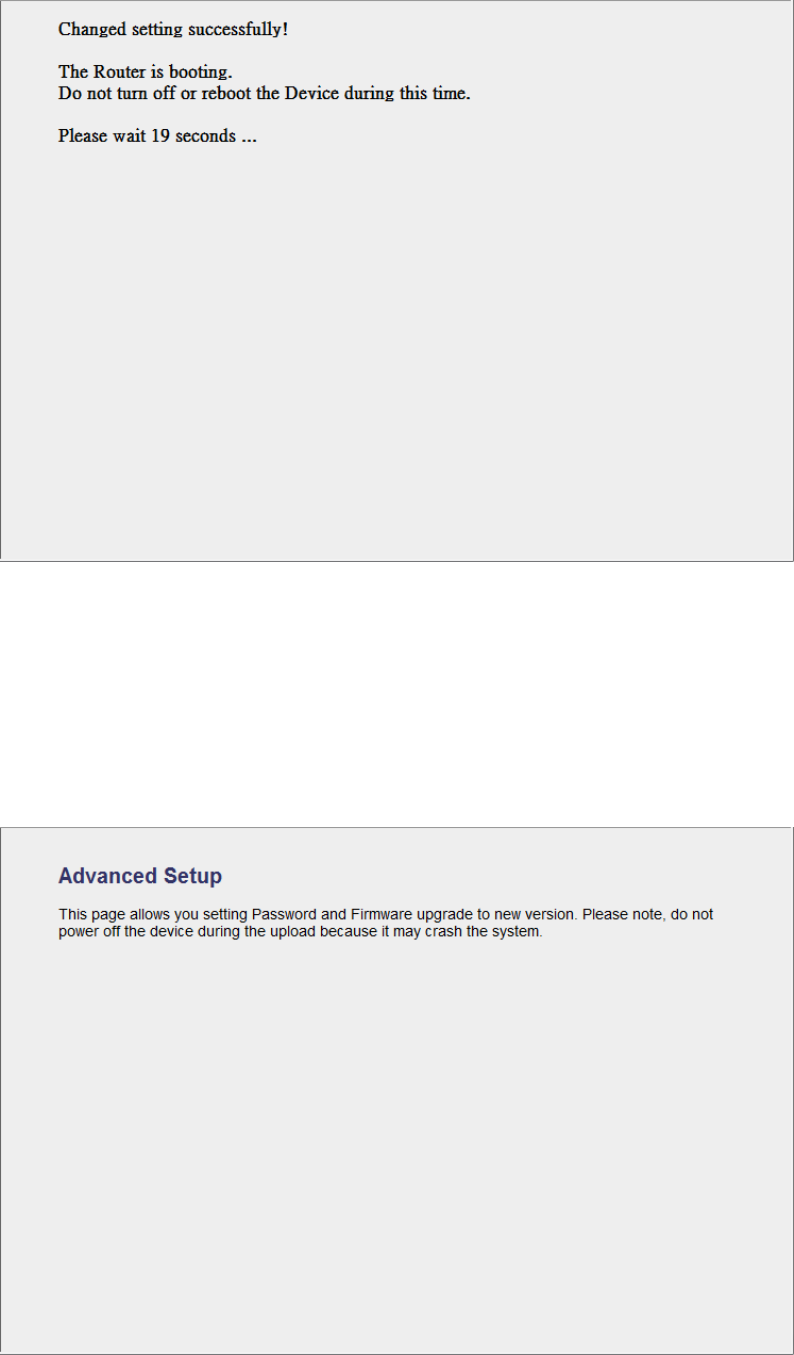
31
3‐2AdvancedSetup
This page allows you setting Password and Firmware upgrade to new
version. Please note: do not power off the device during the Firmware
upgrade because it may crash the system.
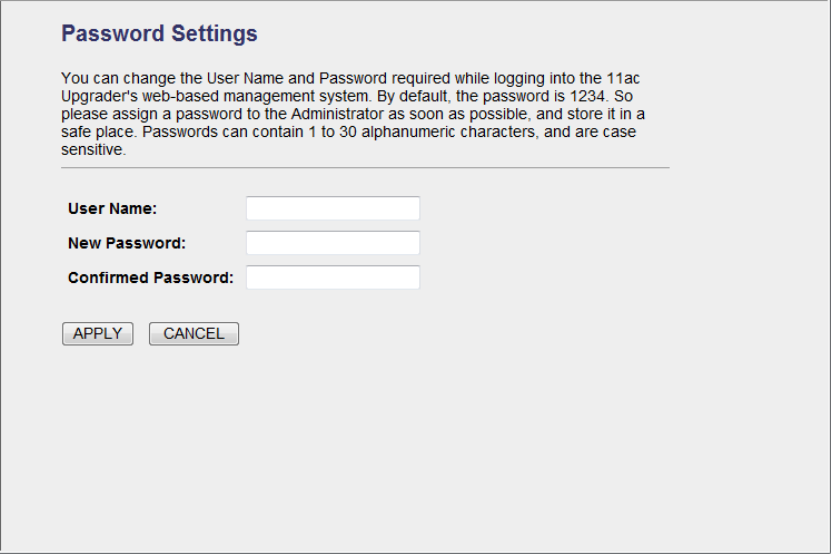
32
Password Settings: You can change the User Name and Password
required while logging into the Band Extender's web-based management
system. By default, the password is 1234. So please assign a password to
the Administrator as soon as possible, and store it in a safe place.
Passwords can contain 1 to 30 alphanumeric characters, and are case
sensitive.
Firmware Upgrade: This tool allows you to upgrade the Band
Extender's system firmware. Enter the path and name of the upgrade file
and then click the APPLY button below. You will be prompted to confirm
the upgrade.
The system will automatically reboot after you finished the firmware
upgrade process.
Please note: Do not power off the device during the Firmware upgrade
because it may crash the system.
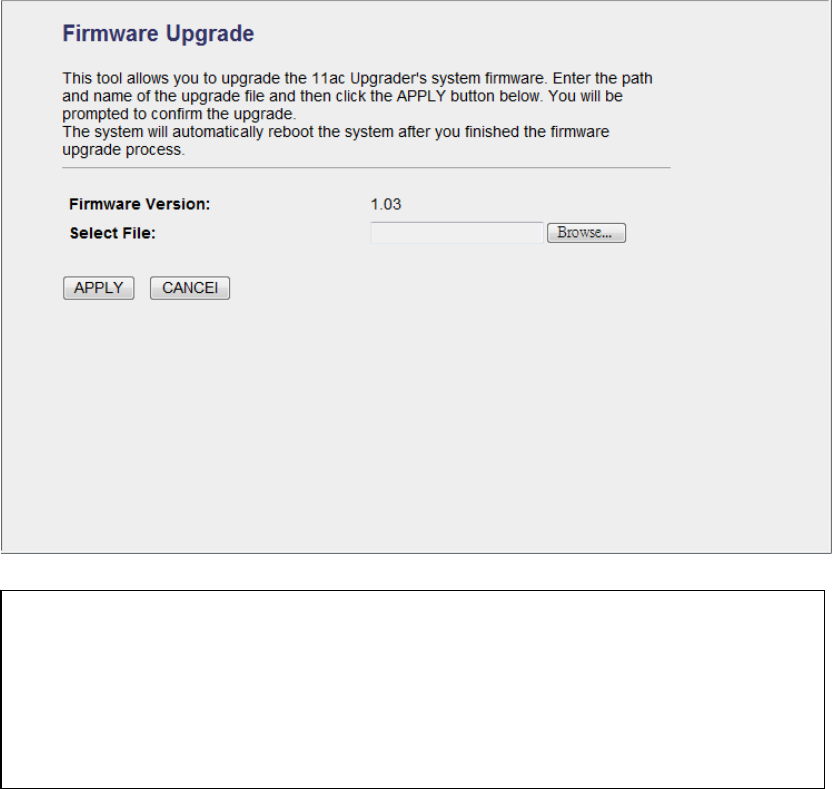
33
3‐3WPSSetup
This page allows you to change the setting for WPS (Wi-Fi Protected
Setup). WPS can help your wireless client automatically connect to the
Root Access Point.
NOTE: Never interrupt the upgrade procedure by closing the web
browser or physically disconnect your computer from Band Extender.
If the firmware you uploaded is corrupt, the firmware upgrade will fail,
and you may have to return this product to the dealer of purchase to
ask for help. (Warranty voids if you interrupted the upgrade
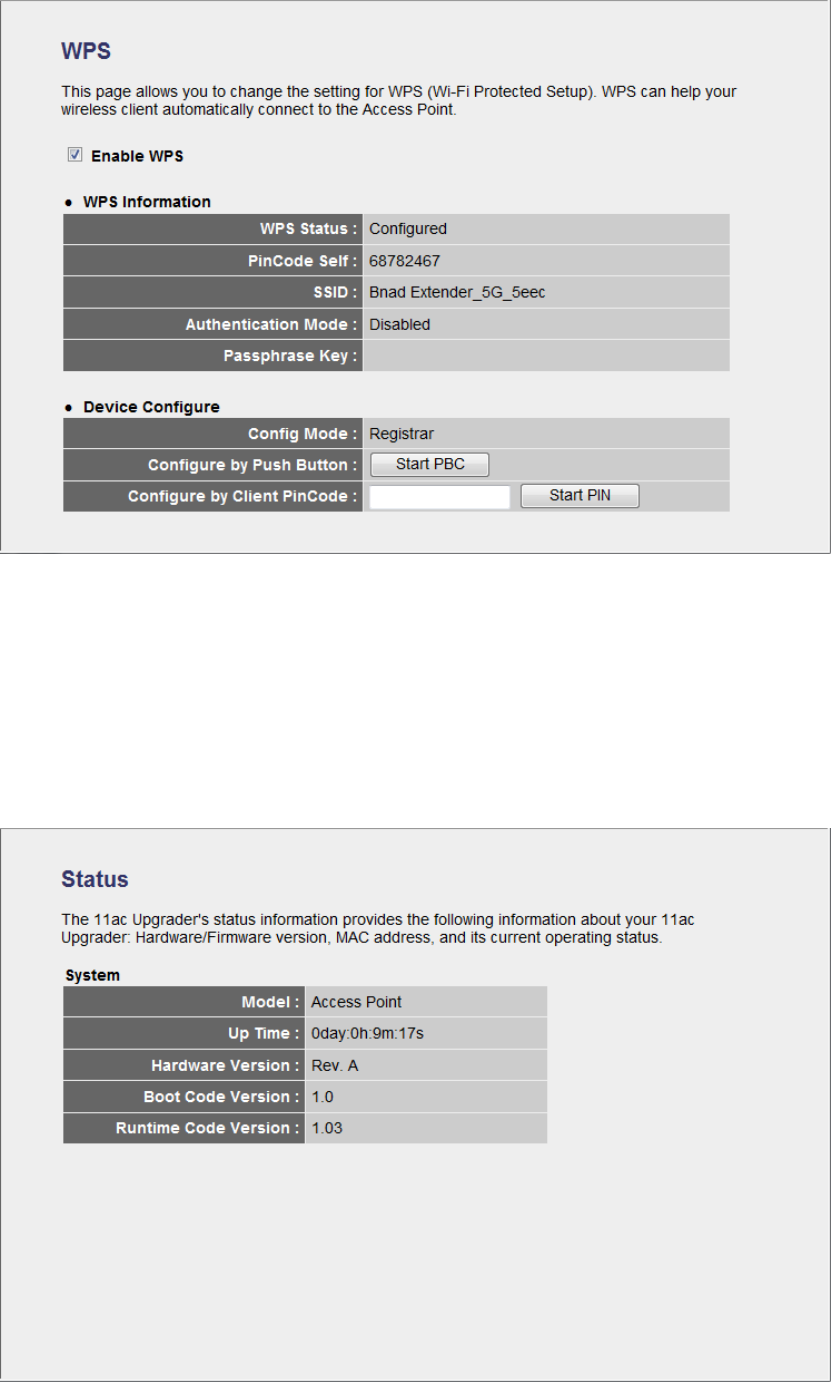
34
3‐4Status
The Band Extender's status information provides the following
information about your Band Extender: Hardware/Firmware version,
and its current operating mode.
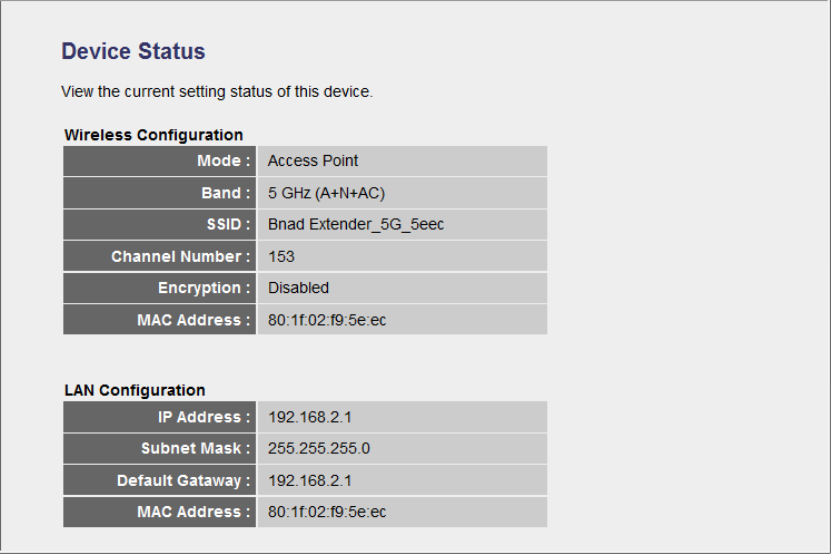
35
Device Status: View the current setting status of this device.
36
ChapterIV:Appendix
4‐1HardwareSpecification
CPU: REALTEK RTL8881AM
RF: REALTEK RTL8881AM
Flash: 2MB
SDRAM RAM: 8MB (CPU inside)
LAN Port: 10/100M Port x 1
Antenna: External Dipole Antenna x 1 (5G)
Power: DC 5V/0.5A USB port power or 5V/0.6A Switching Power Adapter
Dimension: 60 (L) x 50 (W) x 23 (D) mm (without ANT)
Temperature: Operating: 0~40C
Storage: -20~60C
Humidity: Operating: 10~90% (Non-Condensing)
Storage: Max.95% (NonCondensing)
Certification: FCC

37
4‐2Troubleshooting
If you found the device is working improperly or stop responding to you,
don’t panic! Before you contact your dealer of purchase for help, please
read this troubleshooting first. Some problems can be solved by you
within very short time!
Scenario Solution
Device is not
responding to me
when I want to access
it by web browser
a. Please check the connection of power cord
and network cable of this device. All cords
and cables should be correctly and firmly
inserted to the router.
b. If all LEDs on this device are off, please
check the status of A/C power adapter, and
make sure it’s correctly powered.
c. You must use the same IP address section
which router uses.
d. Are you using MAC or IP address filter?
Try to connect the device by another
computer and see if it works; if not, please
restore your device to factory default
settings (pressing ‘reset’ button for over 10
seconds).
e. Set your computer to obtain an IP address
automatically (DHCP), and see if your
computer can get an IP address.
f. If you did a firmware upgrade and this
happens, contact your dealer of purchase for
help.
g. If all above solutions don’t work, contact
the dealer of purchase for help.
Device become hot a. This is not a malfunction, if you can keep
your hand on the device’s case.
b. If you smell something wrong or see the
smoke coming out from device or A/C
power adapter, please disconnect the device

38
and A/C power adapter from utility power
(make sure it’s safe before you’re doing
this!), and call your dealer of purchase for
help.
39
4‐3Glossary
DHCP: Dynamic Host Configuration Protocol. This protocol automatically gives
every computer on your home network an IP address.
DNS Server IP Address: DNS stands for Domain Name System, which allows
Internet servers to have a domain name (such as www.Broadbandrouter.com) and one
or more IP addresses (such as 192.34.45.8). A DNS server keeps a database of
Internet servers and their respective domain names and IP addresses, so that when a
domain name is requested (as in typing "Broadbandrouter.com" into your Internet
browser), the user is sent to the proper IP address. The DNS server IP address used by
the computers on your home network is the location of the DNS server your ISP has
assigned to you.
Ethernet: A standard for computer networks. Ethernet networks are connected by
special cables and hubs, and move data around at up to 10/100 million bits per second
(Mbps).
Idle Timeout: Idle Timeout is designed so that after there is no traffic to the Internet
for a pre-configured amount of time, the connection will automatically be
disconnected.
IP Address and Network (Subnet) Mask: IP stands for Internet Protocol. An IP
address consists of a series of four numbers separated by periods, which identifies a
single, unique Internet computer host in an IP network. Example: 192.168.2.1. It
consists of 2 portions: the IP network address, and the host identifier.
The IP address is a 32-bit binary pattern, which can be represented as four cascaded
decimal numbers separated by “.”: aaa.aaa.aaa.aaa, where each “aaa” can be anything
from 000 to 255, or as four cascaded binary numbers separated by “.”:
bbbbbbbb.bbbbbbbb.bbbbbbbb.bbbbbbbb, where each “b” can either be 0 or 1.
A network mask is also a 32-bit binary pattern, and consists of consecutive leading
1’s followed by consecutive trailing 0’s, such as
11111111.11111111.11111111.00000000. Therefore sometimes a network mask can
also be described simply as “x” number of leading 1’s.
When both are represented side by side in their binary forms, all bits in the IP address

40
that correspond to 1’s in the network mask become part of the IP network address, and
the remaining bits correspond to the host ID.
For example, if the IP address for a device is, in its binary form,
11011001.10110000.10010000.00000111, and if its network mask is,
11111111.11111111.11110000.00000000
It means the device’s network address is
11011001.10110000.10010000.00000000, and its host ID is,
00000000.00000000.00000000.00000111. This is a convenient and efficient method
for routers to route IP packets to their destination.
LAN: Local Area Network. A LAN is a group of computers and devices connected
together in a relatively small area (such as a house or an office). Your home network
is considered a LAN.
MAC Address: MAC stands for Media Access Control. A MAC address is the
hardware address of a device connected to a network. The MAC address is a unique
identifier for a device with an Ethernet interface. It is comprised of two parts: 3 bytes
of data that corresponds to the Manufacturer ID (unique for each manufacturer), plus
3 bytes that are often used as the product’s serial number.
NAT: Network Address Translation. This process allows all of the computers on your
home network to use one IP address. Using the broadband router’s NAT capability,
you can access the Internet from any computer on your home network without having
to purchase more IP addresses from your ISP.
Port: Network Clients (LAN PC) uses port numbers to distinguish one network
application/protocol over another. Below is a list of common applications and
protocol/port numbers:
Application Protocol Port Number
Telnet TCP 23
FTP TCP 21
SMTP TCP 25
POP3 TCP 110
H.323 TCP 1720
SNMP UCP 161

41
SNMP Trap UDP 162
HTTP TCP 80
PPTP TCP 1723
PC Anywhere TCP 5631
PC Anywhere UDP 5632
Protocol: A protocol is a set of rules for interaction agreed upon between multiple
parties so that when they interface with each other based on such a protocol, the
interpretation of their behavior is well defined and can be made objectively, without
confusion or misunderstanding.
Router: A router is an intelligent network device that forwards packets between
different networks based on network layer address information such as IP addresses.
Subnet Mask: A subnet mask, which may be a part of the TCP/IP information
provided by your ISP, is a set of four numbers (e.g. 255.255.255.0) configured like an
IP address. It is used to create IP address numbers used only within a particular
network (as opposed to valid IP address numbers recognized by the Internet, which
must be assigned by InterNIC).
TCP/IP, UDP: Transmission Control Protocol/Internet Protocol (TCP/IP) and
Unreliable Datagram Protocol (UDP). TCP/IP is the standard protocol for data
transmission over the Internet. Both TCP and UDP are transport layer protocol. TCP
performs proper error detection and error recovery, and thus is reliable. UDP on the
other hand is not reliable. They both run on top of the IP (Internet Protocol), a
network layer protocol.
WAN: Wide Area Network. A network that connects computers located in
geographically separate areas (e.g. different buildings, cities, countries). The Internet
is a wide area network.
Web-based management Graphical User Interface (GUI): Many devices support a
graphical user interface that is based on the web browser. This means the user can use
the familiar Netscape or Microsoft Internet Explorer to Control/configure or monitor
the device being managed.